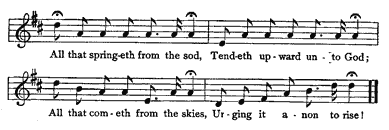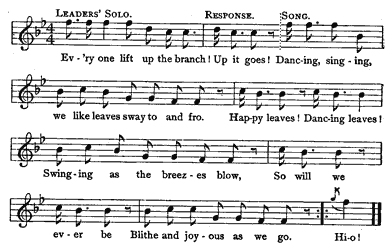The Hé-de Wa-chi
by Alice C. Fletcher
An Omaha Festival of Joy
INTRODUCTORY NOTE.—For centuries the home of the Omaha tribe has been in the region now known as the State of Nebraska, north of the city which bears their name. There they dwelt in permanent villages, surrounded by their garden plots of corn, beans, squashes, etc. From these villages every year in June all the tribes except the sick and infirm went forth to follow the buffalo herds in order to obtain their supply of meat and pelts. As this tribal hunt was essential to the needs of the life of the people, it was a very serious affair, initiated with religious ceremonies and conducted under strict rules enforced by duly appointed officers. It was at the close of this great tribal hunt, when food and clothing had been secured, while Summer lingered and the leaves had not yet begun to fall, so that brightness was still over the land, that this Festival of Joy took place. Like all Indian ceremonies, the Hé-de Wa-chi embodied a teaching that was for the welfare of the tribe, a teaching drawn from nature and dramatically enacted by the people. The Omaha tribe was made up of ten distinct groups, each one having its own name, a set of names for those born within the group, and certain religious symbols and ceremonies committed to its care. By tribal rites and regulations these ten distinct groups were welded together to form the tribe, whose strength and prosperity depended upon internal harmony and unity.
The Hé-de Wa-chi taught the people what this unity really stood for. The central object of the ceremony was a tree, which was the symbol of the tribe; its branches were as the different groups composing the tribe, the twigs that made up the branches were as the individuals that formed the groups.
The Omaha had special ceremonies for the preparation of the central object. They cut a tree, left a tuft of branches at the top and painted the trunk in alternate bands of red and black. The red bands represented day, the black, night; the decoration as a whole stood for the continuity of life. This pole was planted in a broad open space. As the melodious Call to the Ceremony echoed over the land, the people gathered from their tents. Each one of the ten groups took its respective place and all the groups formed a wide circle about the tree. Every one, down to the little children, carried a twig with leaves. These they held aloft as they made their rhythmic, ceremonial approaches to the tree, and afterward danced about the sacred symbol.
It was a wonderful and a beautiful scene that took place on the prairies years ago, when hundreds of Omahas moved to the rhythm of the sacred songs, waving the green sprays as they danced up to the symbolic tree and circled about it with thanksgiving and joy. It was thus they exemplified tribal unity, wherein every one was a part of the living whole.
This ancient American ceremony should live anew with us wherever we gather to enjoy the delights of nature in goodly company.
Directions.—It may be difficult to prepare a young tree for the central pole after the manner of the Omaha; if so, a space around a single tree can be made to serve. Bands of red and black muslin or paper should be put about the tree trunk; these are to symbolize the days and nights enjoyed during the camp life. The members of the camp should be divided into groups and each group have a name and a color. Small branches should be gathered, equal in number to those who will take part in the dance. If actual branches are not available, wands can be used; to these fluttering decorations of green paper should be attached, also a streamer the color of the group. Each group should be assigned a place in the wide circle that is to be made about the tree.
When all are ready the following Call should be sung. The Indian words are retained, as they are easy to pronounce and fit the meaning, and are adapted to the long echoing cadences of the Call.
Song No. 1
The Call
Zha-wa i-ba i-ba e-he, Zha-wa i-ba i-ba ha e-he.

[Words: Zha-wa = to rejoice; i-ba = come; ha = vowel prolongation of the syllable ba; e-he = I bid you. "I bid you come to rejoice."]
This English translation of the native words does not convey the stirring appeal of the Omaha: "To rejoice! Come! I bid you." The stress of the music of the Call is on "Zha-wa," to rejoice; the notes which carry the words "e-he," "I bid you," seem to float afar as if to reach the most distant member of the tribe with the summons. The cadence of the Call echoes itself, as the second line is like the first, only lower in tones.
When all of the camp have gathered in response to the Call, each group must stand in its appointed place and every member hold a decorated wand. Four beats of the drum are now to be given; the beats must not be loud or rapid. When the reverberations of the drum cease, absolute quiet must be maintained, each one's wand must hang downward from his right hand, while the following chant is given, sung by the leaders of the groups. The words are by John B. Tabb, the music is arranged from the Omaha invocation.
Song No. 2
Invocation
All that springeth from the sod, Tendeth upward unto God; All that cometh from the skies, Urging it anon to rise.

This chant takes the place of the prayer sung at this point of the ceremony by the Omaha Keepers of the Tribal Sacred Pipes. The prayer in the original has no words, vocables only are used, for the music is what carries the appeal to Wakon'da (God).
At the close of the chant two strokes of the drum should be given. Then the leaders should sing the first line of the following song; all the camp respond at the beginning of the second measure, and the song follows. This music is the dance song of the ceremony when all the Omaha tribe made four rhythmic advances toward the sacred tree, stopping at the close of each advance. The song was sung four times, once for each forward movement.
Song No. 3
Approach to the Tree
Leaders: Ev'ry one lift up the branch!
Response by all: Up it goes!
Song by all: Dancing, singing, we like leaves sway to and fro.
Happy leaves! Dancing leaves!
Swinging as the breezes blow,
So will we ever be
Blithe and joyous as we go.
Hi-o!

"Hi-o!" is the call given by the leaders for the dancers to pause. When this call is heard, all the branches must be at once lowered and every person stand still. After a brief pause the leaders will again sing the command, "Ev'ry one lift up the branch!" then comes the response, "Up it goes!" The song immediately follows, all the wands held high and waving in rhythm to the melody while the second advance is made. Each one of these advances should be but a few steps, on account of the limitations of space. The dancing steps, the rhythmic movements of the body and the swaying wands should give an undulating line suggestive of waving branches. The available space on the grounds should be calculated so as to permit the four approaches accompanied by the dance-song to reach a point near the tree, yet far enough to permit the forming of two circles of dancers around its base. At this point the company should divide into two parts, one part to form an inner circle and the other to form an outer circle. These two circles are now to dance around the tree, one to go from right to left, the other from left to right. At this time the leaders tie their wands to the trunk of the tree, but all the others retain their wands while they dance in these concentric circles. All should sing the dance-song, keeping time with the feet and waving the wands to the rhythm of the music. As the dance goes on, the time can be accelerated and the circles become wider and narrower, but in all these movements the rhythm of song and dance must never be broken—for the rhythm stands for the binding force of a common, social and loving life.
Song No. 4
Dance Around the Tree
1
Dance the leaves in sunlight,
Dance the leaves in dark night,
Leaves ever, ever dance on the tree,
The Tree!

2
High we lift the green branch,
Dance and wave our green branch,
Each one is a green branch of the tree,
The Tree!
3
Now we all return them,
Bind them to the tree stem,
While we sing the glad word, Unity!
O Tree!
4
Strong our hearts in daylight,
Strong our hearts in still night,
Thus the Hé-de Wa-chi bids us be,
O Tree!
This dance-song can be repeated as often as desired. When at last the leaders wish it to stop they must give the call, "Hi-o!" as they did for the pause in the Dance of Approach to the Tree.
When this signal is given, the members should toss their wands at the foot of the tree from the place where they had stopped dancing.
In the ancient Omaha ceremony the people had the vast expanse of the prairie at their disposal, yet each tribal group kept its appointed place, not only during the dance, wherein they made four approaches toward the sacred tree, but when all the groups formed into two great circles the tribal order of their relative positions was still preserved. The two circles were made up according to sex. The women and girls danced in one direction next to the pole; the men and boys formed the outer circle and danced in the opposite direction. This dance was the occasion of much hilarity and fun. Old and young danced with vigor, and great was the delight of the tribe as it spun around the emblematic tree, carrying branches. At the close of the dance all tossed the branches at the foot of the pole, leaving a mound of green on the widespreading plain.
If boys and girls take part, as they should, in this ceremony, let the girls form the inner circle and the boys the outer circle as they dance about the tree in true Omaha fashion.
In real Indian life every vocation has its accompaniment of song, no matter how homely may be the employment. So, keeping faith with that ancient American custom, let the camp be put in order after the ceremony while all sing the following song, which may be called the Clearing Up:
Song No. 5
The Clearing Up

Now is our dancing ended,
Light are our hearts as our footsteps
Turn at our leaders' bidding.
Safely we gather together
Branches that served our playtime,
Setting our camp all in order
Ere to our tents we betake us.
This scene, in which all should take part, can be made merry as well as useful.